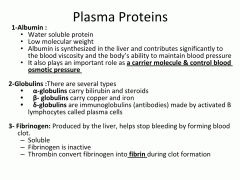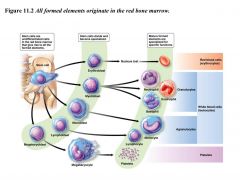![]()
![]()
![]()
Use LEFT and RIGHT arrow keys to navigate between flashcards;
Use UP and DOWN arrow keys to flip the card;
H to show hint;
A reads text to speech;
15 Cards in this Set
- Front
- Back
|
What is blood made up of? |

|
|
|
Plasma proteins includes... |

|
|
|
Hematopoiesis is...
|

The process by which the formed elements of blood develop is called hemopoiesis (hematopoiesis).
In adults, blood cells are formed in red bone marrow from stem cells. They mature in bone marrow or lymphoid tissue In Embryo they are formed in liver, spleen, thymus, lymph nodes in addition to the red marrow |
|
|
Formed Elements in Red bone marrow |

|
|
|
White blood cells (leucocytes)
|
Remove wastes, toxins, and damaged and abnormal cells
Help defend the body against disease Can leave the circulatory system and move to the site of infection or tissue damage Some are capable of phagocytosis |
|
|
Disorders of WBC |
Leukemia: A cancer of the WBCs that causes the number of WBCs to greatly increase. These abnormal cells take over the bone marrow, preventing the development of normal RBCs, WBCs, and platelets. Symptoms include anemia and inadequate clotting and body defense mechanisms. Treatment typically involves radiation therapy, chemotherapy, and transfusions. Bone marrow transplants can help.
Infectious mononucleosis: Viral disease of the lymphocytes caused by the Epstein-Barr virus. Symptoms include fever, headache, sore throat, and swollen lymph nodes. There is no treatment |
|
|
Platelets |
Megakaryocytes are huge cells that splinter into 2000 to 3000 fragments while still in the red bone marrow.
Each fragment, enclosed by a piece of the plasma membrane, is a platelet. Platelets leave the red bone marrow and enter the circulation as an irregularly shaped disc with many vesicles but no nucleus. Have a short life span (5 to 9 days) and they don’t have much mass Their granules contain chemicals that, once released, promote blood clotting |
|
|
Red Blood Cells |
Also called erythrocytes.
Transport oxygen to the cells Carry about 23% of the blood’s total carbon dioxide Shaped like biconcave disks and are very flexible No nucleus when mature Contain hemoglobin(Oxygen-binding pigment in RBCs) Red blood cells (RBCs) make up the bulk of the blood cells. The normal RBC mass is between 40–45% by volume – this is called the hematocrit (Hct), The Hct = 38-46 % females, 40-54% for males Lack mitochondria, they don’t use any of the oxygen they carry, use ANEROBIC glycolysis Don't have a nucleus, do not divide Destined to die in about 120 days.With a very specific purpose to carry O2 to the tissues of the body Contains Hemoglobin. |
|
|
Reticulocytes
|
The rate of erythropoiesis is measured by the number of immature RBCs (called reticulocytes or retics ) in the peripheral circulation
A low reticulocytes count (<.5%) indicates a low rate of erythropoiesis while an elevated rate (>2%) indicates a high rate of erythropoiesis. As cells mature in the bone marrow, they become smaller, the nucleus disappears, and the amount of Hgb increases . Although normally 1-2% of the RBCs in the peripheral circulation are retics, any cell more immature (i.e. proerythroblasts) should never be seen - their presence indicates aleukemia cancer |
|
|
The structure of hemoglobin
|
Each molecule has four subunits
Each subunit has a polypeptide chain and a heme group The iron ion of the heme group binds to oxygen Hemoglobin has a much greater affinity for carbon monoxide than for oxygen Odorless and tasteless An insidious poison |
|
|
Erythropoiesis
Production of RBCs and abnormalities |
Erythropoiesis is the part of hematopoiesis that deals with the production of RBCs.
Erythropoiesis increases when states of hypoxia (O2 deficiency) stimulates the kidneys to release the hormone erythropoietin (EPO) EPO circulates to the red marrow and speeds up the maturation and release of immature red cells Anemia is a condition of insufficient RBC’s or hemoglobin (quality or quantity) It is most often the result of low iron intake, hemolysis, autoimmune disease, blood loss, or lack of production in the bone marrow. Polycythemia is a condition of excess number of RBCs. It occurs in response to hypoxia (natural “blood doping” is training at high altitude), shots of EPO (illegal “doping”), smoking (COPD), or dehydration |
|
|
Anemia Disorders of Red Blood Cells |
The blood’s ability to carry oxygen is reduced
Causes : Can result from too little hemoglobin, too few red blood cells, or both Symptoms: include fatigue, headaches, dizziness, paleness, breathlessness, and heart palpitations
Types: Iron-deficiency anemia (most common form, leads to inadequate hemoglobin production) Causes: (A diet that contains too little iron , An inability to absorb iron and Blood loss)
Hemolytic anemia, sickle-cell anemia: (red blood cell destruction exceeds production) Causes: Infections, Defects in the membranes of RBCs, Transfusion of mismatched blood, Hemoglobin abnormalities, Pernicious anemia, occurs when there is insufficient production of red blood cells.
Production of RBCs depends on vitamin B12. Intrinsic factor produced by the stomach lining helps the small intestine absorb vitamin B12 from the diet
Caused by failure to produce intrinsic factor, which makes impossible the absorption of vitamin B12 |
|
|
Sickle-cell disease (SCD)
|
An autosomal recessive disorder. A genetic defect in the primary DNA sequence leads to production of a faulty Hgb β chain, and RBCs that take on a rigid, sickle-shape
Sickling decreases the cells' flexibility and results in a variety of complications; life expectancy is shortened |
|
|
Blood Clotting Disorders
|
Hemophilia
Inherited condition characterized by excessive bleeding Caused by faulty gene involved in the production of clotting factors Treatment involves restoration of the missing clotting factor Formation of unnecessary blood clots can have immediate health consequences Clots can disrupt blood flow and cause heart attack or stroke A clot that continues to circulate is called an embolus A clot that lodges in an unbroken blood vessel is called a thrombus |
|
|
Rh Factor
|
First discovered on the rhesus macaque (Macaca mulatta), also called the rhesus monkey
Another important antigen Individuals who have Rh antigens on their RBCs are Rh-positive Individuals who lack Rh antigens on their RBCs are Rh-negative An Rh-negative person will not form anti-Rh antibodies unless he or she has been exposed to the Rh antigen transfusion, having given birth to an Rh-positive baby Hemolytic disease of the newborn Anti-Rh antibodies can develop in the mother. They can cross the placenta, destroying the Rh-positive fetus’s RBCs. The baby may die or be very anemic RhoGAM A serum containing antibodies against the Rh antigens given to an Rh-negative mother to destroy any Rh-positive fetal cells in her circulation and thereby prevent her production of anti-Rh antibodies |

